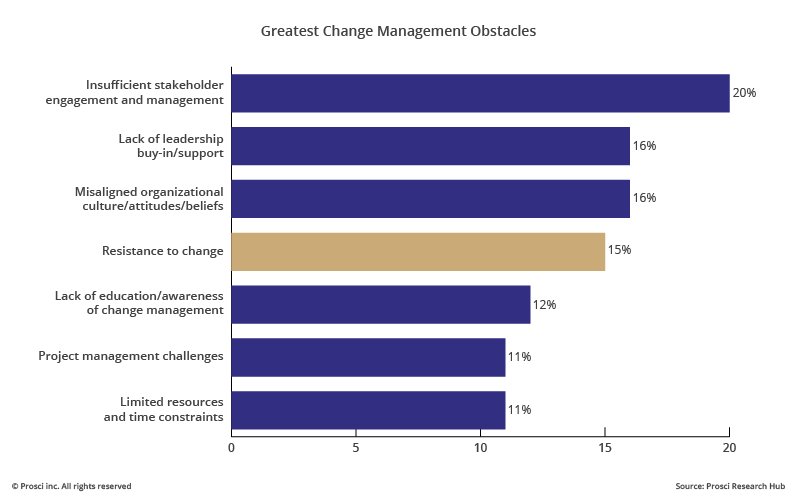The Case for Resistance Prevention in Change Management
5 Mins
Updated: August 1, 2024
Published: December 6, 2023

When implementing change, many organizations commit considerable time, effort and resources to responding to resistance. However, it can be very difficult to mitigate resistance once it becomes a widespread and growing response from members of impacted groups. A more successful approach is to proactively prevent or mitigate resistance by building change readiness from the start of a change.
Resistance to Change
Impedes Success
Think of a time when you experienced a significant change. How did you react? What emotions did it stir in you? Reactions to a change can vary greatly, from fear and disengagement to low morale and loss of trust. Although these reactions are only human, resistive behaviors have significant impacts on your ability to achieve successful outcomes.
In fact, resistance to change has remained one of the greatest obstacles to change success in Prosci's 25 years of change management research, ranking fourth in the most recent Best Practices in Change Management study.

Many Factors Influence
Resistance to Change
Although resistive behaviors are natural, the ways people react to organizational change can relate to both personal and organizational factors, including the ways change is managed in your organization. Common factors that influence how people react to change in an organizational setting include:
- Degree of impact of the change on an individual’s work. Resistance is a function of disruption. The more disruption people experience as a result of a change, the stronger the resistance response you can expect them to demonstrate.
- Personal factors including an individual’s finances, age, health, mobility and family situation can all influence their response to a change.
- Amount of change people are already dealing with, both from an organizational and a personal perspective. Do the people impacted by a change have the capacity to adopt and use it? Or have they reached or exceeded their capacity for change?
- Credibility and trustworthiness of the people leading the change. If the senior leaders driving the change are perceived as lacking credibility and not trustworthy, the need for the change is likely to be contested.
- Alignment of the change with organizational and individual value systems. If the change is not aligned with and supportive of the organization’s culture, a significant resistance response is likely.
- Organization’s history of handling change. If an organization has a history of failed changes and has not learned from those failures, people are likely to be skeptical of any subsequent changes.
A Significant Amount of
Resistance to Change Can Be Avoided
As a change leader, you have likely experienced plenty of resistive behaviors on your change projects—and plenty of frustration as a result. But did you know that a significant amount of resistance can be avoided?
In Prosci’s benchmarking research, 41% of respondents reported that over half of the employee resistance they experienced during change could have been avoided by effectively applying change management. And 43% said that over half the manager resistance they experienced was avoidable.
Often, people assume that resistance occurs during organizational change because those demonstrating resistive behaviors are stuck in their ways or lack motivation. But the top reason for employee resistance is lack of awareness of why the change is needed. Prosci's research bears this out.


Fortunately, you can significantly mitigate these reasons for employee and people manager resistance by applying effective change management and proactively building change readiness.
2 Avenues of
Resistance Management
Building change readiness is a key aspect of the Prosci Methodology, which defines two avenues or approaches for managing resistance:
1. Resistance prevention
Resistance prevention should be your primary avenue of resistance management. It is defined as planning for and addressing or eliminating resistance by effectively applying change management.
Preventing change resistance requires you to anticipate and identify potential resistance before it occurs. You should identify which impacted groups are likely to resist the change, the issues that will influence their resistance response and take action to mitigate or eliminate those issues early on.
In the Prosci 3-Phase Process, resistance prevention is built into all three phases. In Phase 1 – Prepare Approach, you anticipate and assess potential resistance, and then identify tactics to address it proactively. Phase 2 – Manage Change integrates resistance management activities into your ADKAR Blueprint and change management plans, including plans for preparing people managers to support their people during transitions.
.png?width=800&height=568&name=small-3-phase-process-with-plain-language-questions%20(1).png)
2. Resistance response
Resistance response is defined as developing effective responses when resistance becomes enduring or persistent. This requires identifying the root causes of any barriers to change and taking appropriate adaptive actions to address the root causes.
In Phase 2 – Manage Change, you track ADKAR outcomes to assess individual progress and to identify any barriers to change to adopting and using a change. You may need to incorporate adaptive actions in your ADKAR Blueprint and change management plans to address the root causes of the barriers to change.
In Phase 3 – Sustain Outcomes, you continue to measure the ADKAR outcomes to ensure that the change is reinforced at the individual level, so it “sticks."
10 Benefits of
Prioritizing Resistance Prevention
If you could prevent the fear, sadness, disengagement, negativity, workarounds, low morale, loss of trust, absenteeism, mistakes, attrition, and more that your people experience during organizational changes, why wouldn’t you? The greatest opportunity to influence change success is to prevent resistance by building change readiness.
Here are 10 benefits of prioritizing resistance prevention:
1. Save time and money
Preventing resistance by building change readiness takes less effort, is more cost effective and has a higher potential for success compared to responding to resistance.
2. Lower rate of resistance
Anticipating and addressing issues beforehand leads to a lower incidence of resistance during the implementation of a change.
3. Build in quality
Integrating change smoothly from the start ensures that the change is implemented with high quality and efficiency.
4. Approach resistance proactively
Prevention is proactive, allowing organizations to get ahead of potential issues and challenges.
5. Increase commitment
Anticipating and addressing concerns early fosters greater commitment to the change from impacted individuals and groups.
6. Accelerate adoption
A proactive approach accelerates the adoption and use of changes within an organization.
7. Build trust
Acknowledging and addressing concerns builds trust among impacted individuals and groups.
8. Improve efficiency and focus
Mitigating or eliminating resistance enables more efficient use of resources and provides more capacity for focusing on what truly matters during the change process.
9. Create a healthier workplace
Anticipating and addressing resistance creates a positive and supportive work environment, reducing stress and frustration.
10. Increase success rates of changes
By preventing resistance, organizations increase the likelihood of achieving change objectives successfully and on time.

Steps to Prevent and Resolve
Resistance to Change
We asked 1,400 webinar attendees where they currently focus their resistance management efforts during change—resistance prevention or resistance response. The most prevalent response was resistance prevention 60% of the time and resistance response 40% of the time. When we asked where they believed they needed to focus, attendees indicated they felt they should focus on resistance prevention 80% of the time.
You can get started on improving your ability to prevent and resolve resistance on your change projects by taking these four steps:
1. Promote mindset shifts
Start by promoting mindset shifts that effectively anticipate and address resistance. You and the people-facing roles (sponsors and people managers) you support need to adopt and role model mindset shifts from "How do we manage resistance to change?" to "How do we build readiness for change?"
| Examples of Mindset Shifts | |
| From “Everyone has to change” | To “Everyone has a choice to change” |
| From “People are resisters” | To “People are displaying resistive behaviors” |
| From “Resistance is a negative response to be overcome, dismissed or minimized” | To “Resistance is a positive opportunity to listen, understand and respond” |
2. Build change readiness
The Prosci Methodology offers a structured approach to proactively prepare, equip and support people to be able to adopt and use a change. The effective application of the methodology requires open and transparent communications, engaging people in the change process, active listening, and responding to their feedback.
3. Prevent barriers to change
Anticipate and identify potential resistance by identifying which impacted groups are likely to resist the change, the issues that will influence their resistance response and taking action to mitigate or eliminate those issues early on.
4. Resolve barriers to change
Identify the root causes of any barriers to change, determine how to resolve the barriers and take appropriate adaptive actions.
Understanding Resistance to Change
With the right understanding of resistance, why it occurs, and the use of a structured approach for managing change, a significant amount of resistance can be avoided on your change projects and initiatives. Proactively avoiding and mitigating resistance can save time, money and anguish for all involved while enabling critical changes to move forward faster. And, most importantly, you will increase the success rates for your organizational changes.


